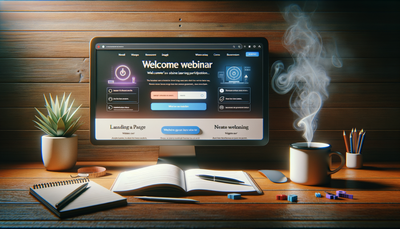Using Heatmaps to Improve Landing Page Performance
Heatmaps are powerful visual tools that can significantly enhance the performance of your landing pages. By providing a graphical representation of user behavior, heatmaps offer invaluable insights into how visitors interact with your website. This article delves into the world of heatmaps, exploring their various types and how to effectively interpret and act on the data they provide. We'll cover click maps, scroll maps, and attention maps, demonstrating how each can be leveraged to optimize your landing page layout and content for improved conversions. Whether you're new to heatmaps or looking to refine your optimization strategies, this guide will equip you with the knowledge to make data-driven decisions and create more engaging, high-converting landing pages.Table of Contents:
-
Understanding Heatmaps: A Powerful Visualization Tool
- Click Maps: Identifying User Interaction Hotspots
- Scroll Maps: Analyzing Content Visibility and Engagement
- Attention Maps: Understanding Visual Focus
- Implementing Heatmap Insights for Conversion Improvement
- Best Practices for Heatmap Analysis
- Click Maps: Identifying User Interaction Hotspots
- Scroll Maps: Analyzing Content Visibility and Engagement
- Attention Maps: Understanding Visual Focus
- Implementing Heatmap Insights for Conversion Improvement
- Best Practices for Heatmap Analysis

Understanding Heatmaps: A Powerful Visualization Tool
Heatmaps are visual representations of data that use color-coding to display how users interact with a webpage. They offer a quick and intuitive way to understand complex data sets, making them invaluable for website optimization.These tools work by collecting data on user behavior and overlaying this information on a visual representation of your webpage. The 'heat' in heatmaps refers to the color intensity used to show the level of user engagement with different areas of the page.
By utilizing heatmaps, you can gain insights into where users click, how far they scroll, and which areas of your page attract the most attention. This information is crucial for making informed decisions about your landing page design and content placement.
Do you need a website? Want to build a website but don't know where to start? Our website builder is the perfect solution. Easy to use, and with the ability to customize to fit your business needs, you can have a professional website in no time.
Click Maps: Identifying User Interaction Hotspots
Click maps are a type of heatmap that show where users click or tap on your landing page. They highlight the areas that receive the most interaction, helping you understand which elements are attracting user attention and which might be overlooked.To interpret a click map, look for areas with high concentrations of clicks. These are your page's 'hotspots' and often indicate elements that users find interesting or valuable. Conversely, areas with few or no clicks may need to be reconsidered or repositioned.
Use click map data to optimize your call-to-action (CTA) buttons, ensure important links are being noticed, and identify any non-clickable elements that users are attempting to interact with. This information can guide you in creating a more intuitive and user-friendly layout.
Scroll Maps: Analyzing Content Visibility and Engagement
Scroll maps illustrate how far down the page users typically scroll. They use a color gradient to show the percentage of users who view each part of the page, with cooler colors indicating less visibility and warmer colors showing higher engagement.When analyzing a scroll map, pay attention to where the colors start to cool off. This 'fold' line indicates where many users stop scrolling, which can help you determine the optimal placement of crucial information and CTAs.
If important content falls below areas with low visibility, consider restructuring your page to bring key elements higher up. Alternatively, you might need to create more engaging content above the fold to encourage further scrolling. Scroll maps can also help you identify if your page is too long or if certain sections are being overlooked.
Building a website with SITE123 is easy
Attention Maps: Understanding Visual Focus
Attention maps, also known as eye-tracking heatmaps, predict where users are likely to look when they land on your page. These maps use algorithms based on eye-tracking studies to simulate user attention patterns.Interpreting attention maps involves looking for areas that receive high visual focus. These are typically elements like headlines, images, and contrasting colors. Use this information to ensure your most important messages and CTAs are placed in high-attention areas.
If crucial elements are not receiving the expected attention, consider adjusting their size, color, or position. Remember that users often follow an F-shaped pattern when scanning web content, so aligning your key information with this pattern can increase visibility and engagement.
Implementing Heatmap Insights for Conversion Improvement
To effectively use heatmap data for improving conversions, start by establishing a baseline of your current landing page performance. Then, use insights from click, scroll, and attention maps to make targeted improvements.For example, if your click map shows that users are not interacting with your main CTA, try changing its color, size, or position. If the scroll map indicates that important information is being missed, restructure your content to bring key elements above the fold.
Remember to make changes incrementally and A/B test your modifications. This approach allows you to attribute improvements directly to specific changes. Continuously monitor your heatmaps and conversion rates, and be prepared to iterate your design based on new data.
Best Practices for Heatmap Analysis
When working with heatmaps, keep these best practices in mind:1. Collect sufficient data: Ensure you have a statistically significant sample size before drawing conclusions.
2. Consider context: Analyze heatmaps in conjunction with other data sources like analytics and user feedback.
3. Segment your data: Look at heatmaps for different user groups, devices, and traffic sources to uncover more specific insights.
4. Regular review: Continuously monitor your heatmaps, as user behavior can change over time or in response to site updates.
5. Test and validate: Always test your changes and validate the results with both heatmaps and conversion data.
By following these practices, you'll be well-equipped to make data-driven decisions that significantly improve your landing page performance.





